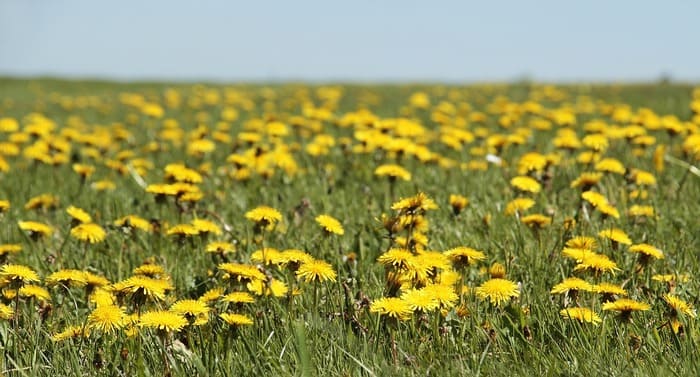
Would you like to learn to play the notes of Dandelions on the piano? Then you’ve come to the right place!
In 2017, Ruth B released her first studio album entitled “Safe Haven”, a captivating album that includes the iconic song Dandelions.
Dandelions quickly captured the hearts of audiences with its poetic lyrics and haunting melody. The song appealed to a wide range of listeners, becoming much more than a simple musical composition.
Today, many piano enthusiasts are looking to learn how to play this magnificent song.
In this article, we’ll take you step by step through the notes of Dandelions on the piano. We’ll start by breaking down the parts for the right hand, then for the left, before gradually combining them to play the song as a whole. Detailed video tutorials will accompany each step of your musical journey, helping you acquire the skills you need to perform this work with confidence and precision.
Our ultimate aim is to help you master Dandelions on the piano, so that you can express all its emotion and beauty through your own interpretations.
Are you ready to immerse yourself in this musical journey? Then get ready, because the adventure begins now!
Bonus : you can also learn to play this song at your own pace on our interactive piano learning app La Touche Musicale.
Free download: >> >> The guide to learn 10 easy piano pieces.
Learn to play your favorite songs on the piano
The La Touche Musicale learning app offers more than 2,500 songs to play easily on the piano. Connect your piano to your device and learn to play them at your own pace while having fun.
In this introductory section, we’ll revisit the basics of piano playing for those of you who might need a refresher. If you’re already familiar with the positioning of the keys on the keyboard and the name of each note, you can skip ahead to the next section. However, if you need a refresher, concentrate on the diagram below:

The name of the notes on a piano keyboard.
In the keyboard layout you’re about to discover, each key is associated with a musical note, from C to B. You’ll notice that the black keys are grouped in twos or threes, providing a useful visual cue on the keyboard.
To locate a specific note, use C as a constant reference point. It’s always located on the white key immediately to the left of a group of two black keys. Once you’ve identified the note C, it becomes easier to locate other notes such as D, G and B.
Practice identifying these different notes on the keyboard. Once you feel comfortable, the instructions for playing Dandelions on the piano will seem much more accessible.
Take the time to familiarize yourself with the keyboard layout and practice locating the notes. This will be of great benefit to you as you learn to play the piano. Now, are you ready to dive into learning this piece? Let’s get on with it!
Now that you’ve got the basics down for navigating the piano keyboard, let’s concentrate on the essential part: the notes produced by your right hand, which make up the melody of the song Dandelions.
Let’s begin this section by identifying the first note your right hand will play. It’s the note B.
Take your time to locate this note on your keyboard. Once you’ve identified it, you can move on to the next stage of our learning process, where we’ll explore the other notes in the melody to be played with the right hand.

B is the first note to be played with the right hand for the song Dandelions on piano.
Perfect! Now that you’ve located the note B on your keyboard, you’ve established your starting point.
Now you’re ready to move forward into the melodic sequence of Dandelions with your right hand. Chain together the following keys to play the melody:
B – A – F# – F# – E – F# – E – D – B – A – F# – F# – E – E – D – E – D – B – D – E – F# – E – D – F# – A – A – D – E – F# – E – D – E – B – D – D – D – E – F# – B – A – F# – B – D – D – D – E – F# – B – A – F# – D – D – F# – E – D – B – F# – E – D – D – D – D – F# – E – D – F# – D – D – F# – E – D – B – F# – E – D – D – D – D – F# – E – D – F# – D – G – A – G – F# – E – D – F# – F# – E – D – E – F# – E – B – G – A – G – F# – E – D – F# – F# – E – D – F# – E – D – B – A – F# – F# – E – F# – E – D – D – B – A – F# – F# – E – E – E – E – B – B – D – E – F# – E – D – F# – A – A – D – E – F# – E – D – E – D – B – A – F# – F# – E – F# – D – D – B – A – F# – F# – E – E – E – D – B – B – D – E – F# – E – D – F# – A – D – E – F# – E – D – E – D – E – E – E – B – B – D – F# – E – D – D – E – E – E – D – C# – D – E – D – C# – D – E – E – E – B – B – D – F# – E – D – D – F# – E – D – C# – D – C# – A – E – B – D – D – D – E – F# – B – A – F# – B – D – D – D – E – F# – B – A – F# – D – D – F# – E – D – B – F# – E – D – D – D – D – F# – E – D – F# – D – D – F# – E – D – B – F# – E – D – D – D – D – F# – E – D – F# – D – G – A – G – F# – E – D – F# – F# – E – D – E – F# – E – B – G – A – G – F# – E – D – F# – F# – E – D – F# – E – D – B – A – F# – F# – E – F# – E – D – D – B – A – F# – F# – E – E – E – E – B – B – D – E – F# – E – D – F# – A – A – D – E – F# – E – D – E – D – B – A – F# – F# – E – F# – D – D – B – A – F# – F# – E – E – E – D – B – B – D – E – F# – E – D – F# – A – D – E – F# – E – D – E – D – E – E – E – B – B – D – F# – E – D – D – E – E – E – D – C# – D – E – D – C# – D – E – E – E – B – B – D – F# – E – D – D – F# – E – D – C# – D – C# – A – E – B – D – B – D – B – D – D – E – F# – A – B – D – F# – F# – E – D – E – B + D – D + F# – B + D – D + F# – B + D – D + F# – D + F# – E + G – F# + A – A + D – B + D – D + F# – F# + A – F# + A – E + B – D + G – E + G – D – E – F# – A – B – D – B – A – F# – F# – E – E – F# – D – D – B – A – F# – F# – E – E – E – E – D – B – B – D – E – F# – E – D – F# – A – A – D – E – F# – E – D – E – D – B – A – F# – F# – E – F# – D – D – B – A – F# – F# – E – E – E – D – B – B – D – E – F# – E – D – F# – A – D – E – F# – E – D – E – D – E – E – E – B – B – D – F# – E – D – D – E – E – E – D – C# – D – E – D – C# – D – E – E – E – B – B – D – F# – E – D – D – F# – E – D – C# – D – C# – A – E – B – A – F# – F# – E – F# – E – D – B – A – F# – G – F# – E – E – E – D – B – D – E – F# – E – D – F# – A – D – E – F# – E – D – E – F# – B.
By repeating this sequence of notes several times, you will gradually progress in your ability to play the entire Dandelions melody with your right hand on the keyboard. It’s advisable to practice this sequence of notes several times to perfect your ability in this part of the piece.
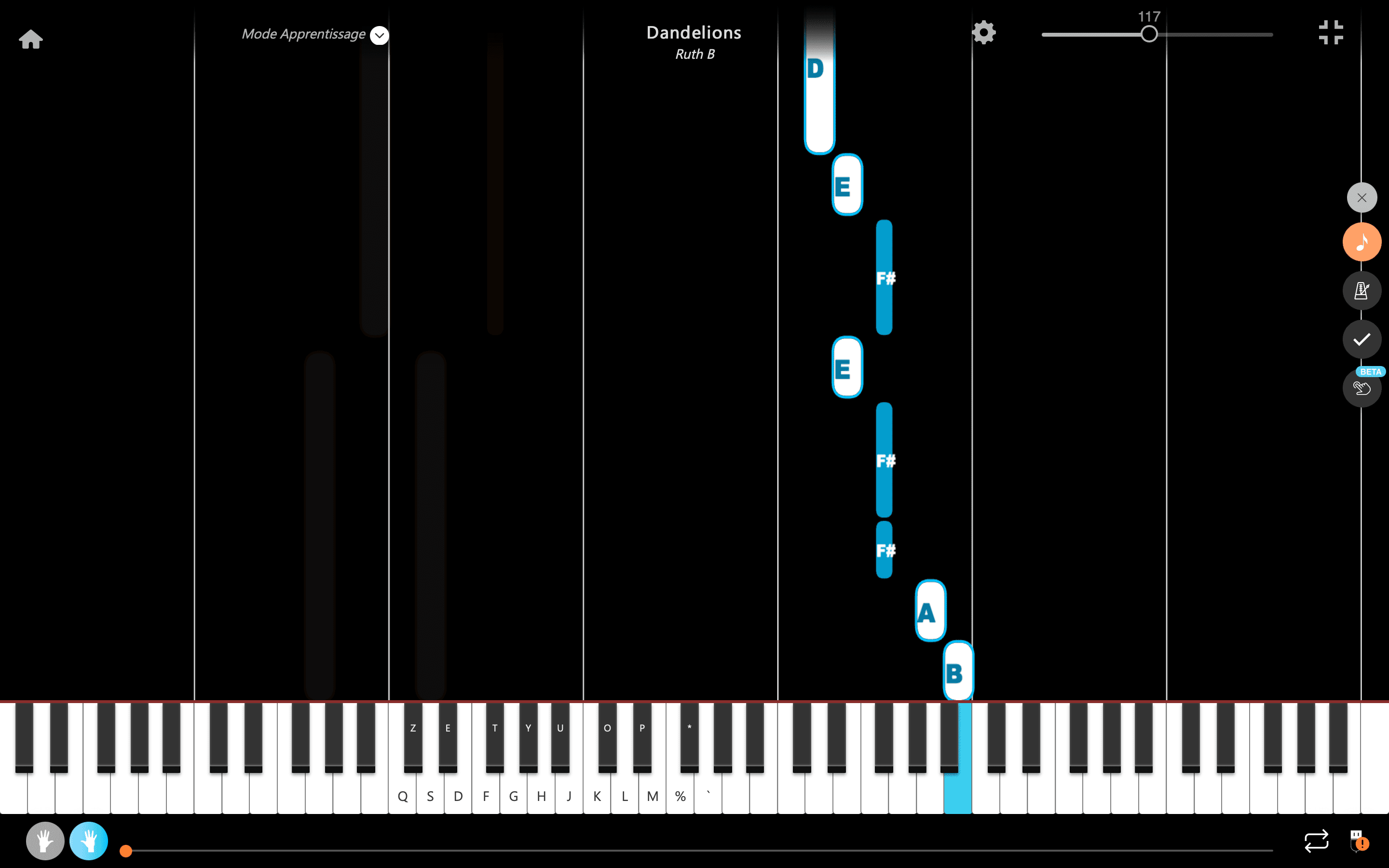
Dandelions on the piano: the notes of the right hand.
To speed up your progress, there’s nothing like a real-time instructional video that shows you precisely which keys to press with your right hand to faithfully reproduce the melody of the piece. Consult our video guide and press the corresponding keys as the notes appear and reach the virtual keyboard. This will make it easier for you to assimilate the melodic sequence and improve your piano skills.
Congratulations! You’ve managed to play the melody of this iconic piece using your right hand!
Now let’s move on to the series of notes your left hand will have to play.
La Touche Musicale app waits for you to play the right note with your right hand on your piano before moving on to the next one.
It’s generally said that the left hand on the piano establishes the chords, providing the harmonic foundation, while the right hand manages the main melody. The left hand enriches your performance by adding nuance and depth to your playing.
To identify the first notes to play with your left hand, we’ll follow a similar approach to that used for the right hand. The first notes you press with your left hand are a G and a D :

G and D are the first notes to be played with the left hand for the song Dandelions on piano.
Can you spot the notes on your keyboard? It’s fantastic!
Now, as with the right hand, let’s concentrate on the notes your left hand will have to play. Press each of the notes listed below in the order indicated to successfully accompany Dandelions with your left hand.
G + D – B + F# – D + A – A + E – G + D – B + F# – D + A – A + E – G + D – B + F# – D + A – A + E – G + D – B + F# – D + A – A + E – G + D – B + F# – D + A – A + E – G + D – B + F# – D + A – A + E – G + D – B + F# – D + A – A + E – G + D – B + F# – D + A – A + E – G + D – B + F# – D + A – A + E – G + D – B + F# – D + A – A + E – G + D – B + F# – D + A – A + E – G + D – B + F# – D + A – A + E – G + D – B + F# – D + A – A + E – G + D – B + F# – D + A – A + E – G + D – B + F# – D + A – A + E – G + D – B + F# – D + A – A + E – G + D – B + F# – D + A – A + E – G + D – B + F# – D + A – A + E – G + D – B + F# – D + A – A + E – G + D – B + F# – D + A – A + E – G + D – B + F# – D + A – A + E – G + D – B + F# – D + A – A + E – G + D – B + F# – D + A – A + E – G + D – B + F# – D + A – A + E – G + D – B + F# – D + A – A + E – G + D – B + F# – D + A – A + E – G + D – B + F# – D + A – A + E – G + D – B + F# – D + A – A + E – A + E – A + E – G + D – B + F# – D + A – A + E – G + D – B + F# – D + A – A + E – G + D – B + F# – D + A – A + E – G + D – B + F# – D + A – A + E – G + D – B + F# – D + A – A + E – G + D – B + F# – D + A – A + E – G + D – B + F# – D + A – A + E – G + D – B + F# – D + A – A + E – G + D.
It is beneficial to repeat this sequence several times until you feel completely comfortable playing it. With enough practice, you’ll be able to play this sequence of notes smoothly.
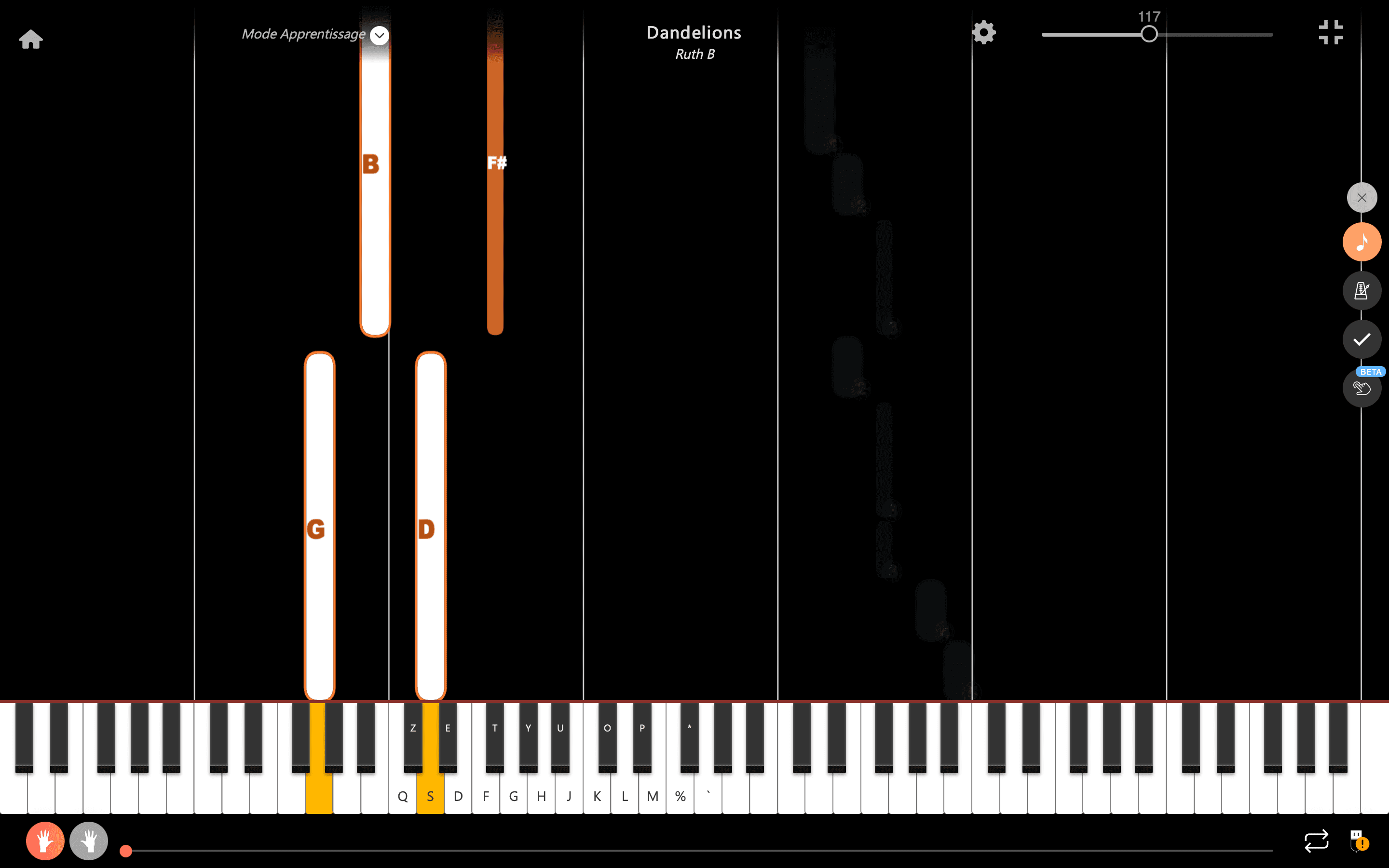
Dandelions on the piano: the notes of the left hand.
We’ve put together a detailed video tutorial that takes you step by step through every note your left hand needs to play for this iconic song. Pay close attention to the instructions given at each step, and watch carefully as your fingers move across the keyboard.
As each note appears on the screen, be sure to locate its position on your own keyboard and press the corresponding key at the right moment to follow the rhythm and guarantee a musical accompaniment faithful to the original.
This video tutorial will provide you with an invaluable resource for perfecting your piano playing, and help you master Dandelions accompaniment with your left hand.
The La Touche Musicale app waits for you to play the correct note with your left hand on your piano before moving on to the next.
Congratulations! You’ve now mastered the right and left hand parts of the Dandelions piece on your keyboard.
Now let’s enter the next phase of your learning process: coordinating the movements of your two hands to create a harmonious musical performance. This will require precise synchronization and careful attention to how the parts of each hand link together to form a single, coherent melody.
Take time to familiarize yourself with the two parts individually, then gradually begin to combine them. Concentrate on the rhythm and timing between your hands, ensuring that each note is played at the right moment and with the right intensity.
This process may seem daunting at first, but with practice and patience, you’ll be able to play Dandelions with ease and expression.
Are you ready for this exciting musical challenge? Let’s embark on this new adventure together!
Mastering two-handed piano playing requires motivation, synchronization and patience. Be kind to yourself; harmonizing your hand movements can be difficult at first.
Remember that learning a new piece on the piano takes time, often several weeks. But once this phase is over, you’ll be able to play your favorite piece fluidly. With regular practice, you’ll know the piece by heart, making sheet music almost superfluous. To help you in this process, the interactive application La Touche Musicale can be an excellent guide.
Here’s a practical tip: divide the composition into passages of a few seconds, ideally between 5 and 10 seconds.
Start by concentrating on the melodic sequence your right hand should play for each fragment of the chosen piece. Repeat it as many times as necessary before moving on to the sequence for the left hand. When you feel comfortable with the individual sequences of each hand for a given fragment, try to synchronize them.
Continue this approach, passage by passage. When you feel ready, try assembling these fragments to create a continuous performance. This progressive method of learning the piano will enable you to appreciate each small step forward and make the challenge as a whole more accessible as you practice.
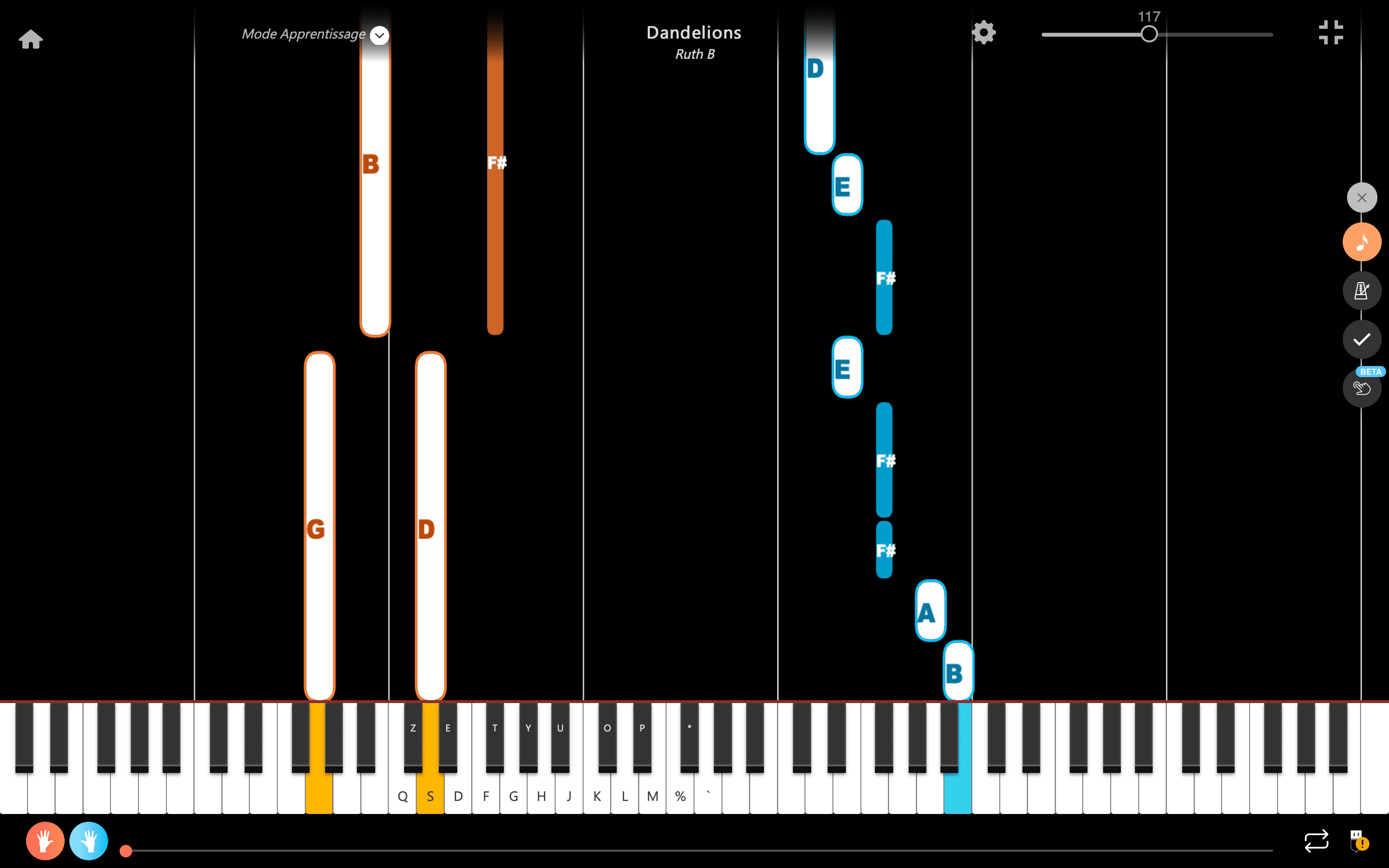
Dandelions on the piano: the notes of both hands.
Check out our complete video that guides you through mastering Ruth B’s Dandelions on the piano using both hands.
Perseverance and regular practice are essential, but be confident in your abilities. Pay attention to variations in rhythm and ensure impeccable coordination between your hands, as mentioned above.
There will be times when you need to press several keys simultaneously to create chords, and other times when notes need to be played sequentially.
If the pace of the video seems too fast, don’t hesitate to pause the video when the notes are displayed, allowing you to adjust the placement of your fingers on the keys to facilitate your learning.
If frequent pausing of the video to readjust your fingers seems tedious, our interactive application La Touche Musicale is here to help. With its interactive options, including a learning mode that advances only when you’ve activated the right keys, it eliminates this constraint. What’s more, it offers a visual representation of musical notes (such as C, D, E, etc.), similar to what you see in our videos. We recommend using this function as a complement to enrich your learning experience.
With a wide selection of pieces covering different styles and skill levels, our app can greatly enhance your piano learning experience. Are you ready to embark on this musical adventure?
Ajoutez votre titre ici
The La Touche Musicale app waits for you to play the right notes with both hands on your piano before moving on to the next.
Well done! You can now play Ruth B’s Dandelions in its entirety on the piano.
If you’ve enjoyed this guide, you should know that we also offer other resources of this type containing a wide variety of famous songs belonging to different musical styles:
Congratulations on completing this mission with the help of this tutorial! You can now perform one of Ruth B’s greatest songs on your keyboard, harmonizing both hands.
To make this experience even richer, we’ve included a link to download the score of Dandelions in PDF format.
Now you’re free to play this song wherever you are.
And don’t forget that for a learning experience that’s as enjoyable as it is educational, our La Touche Musicale application is at your disposal.
We look forward to accompanying you in future piano lessons!
Share the article on:
La Touche Musicale offers powerful AI apps to help you learn, play, and transcribe music effortlessly. Discover them below.
Ideal for: solo piano

Transcribe your piano pieces to sheet music with unrivalled precision.
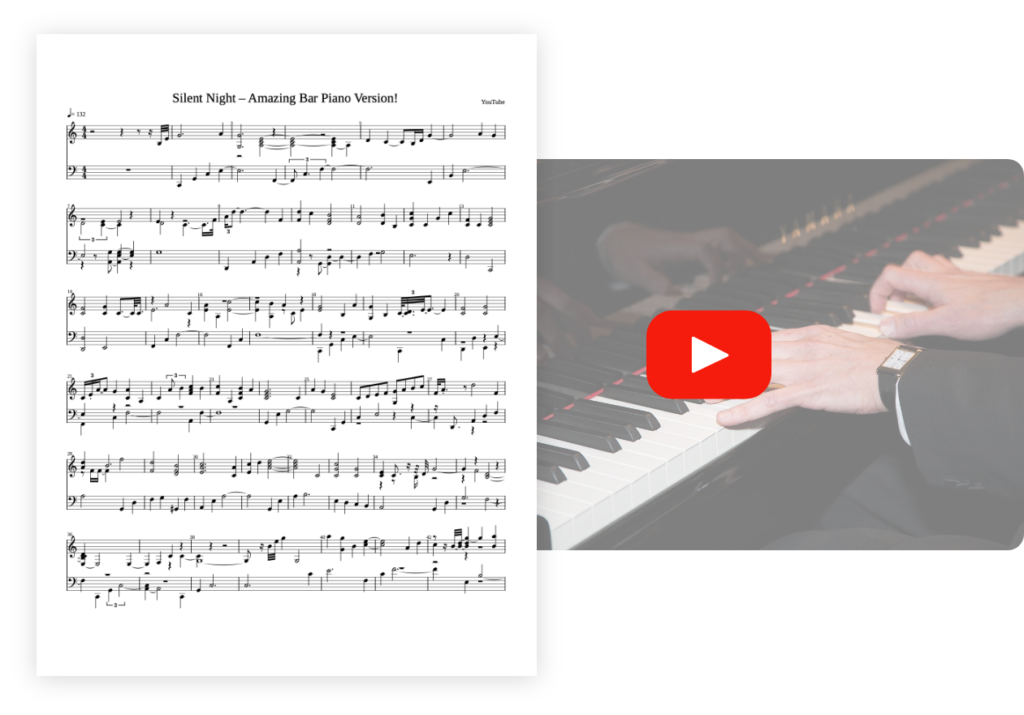
Ideal for: solo guitar

Transcribe your guitar tunes into tablature with unrivalled precision.
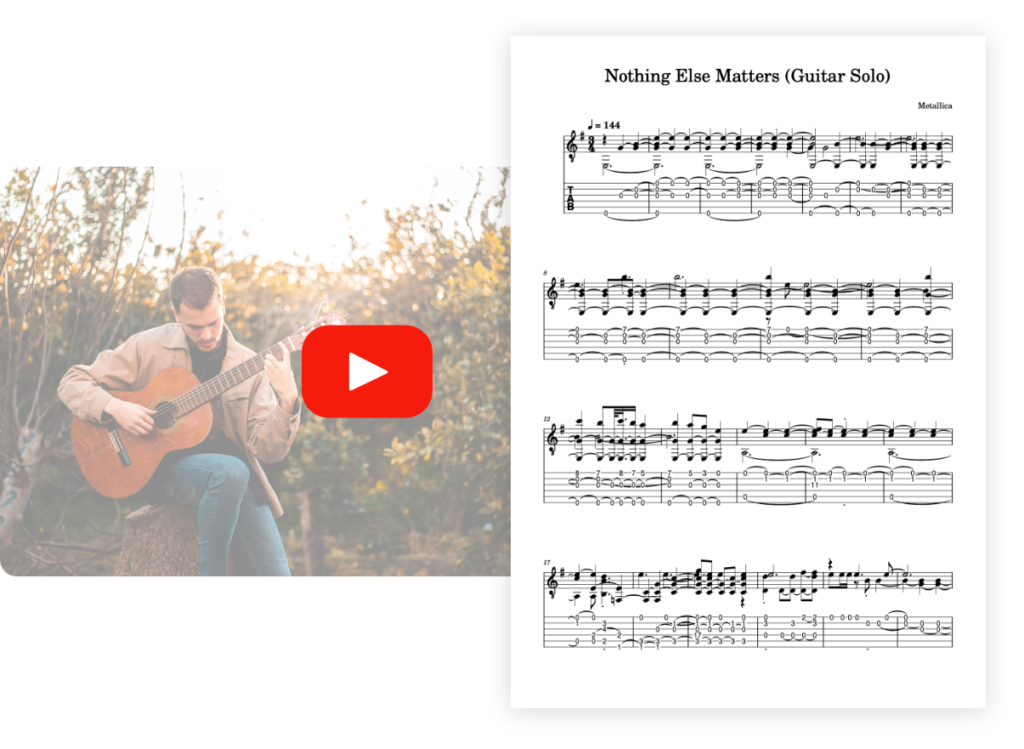
Ideal for: solo vocals

Transcribe your vocal recordings into sheet music with unrivalled precision.
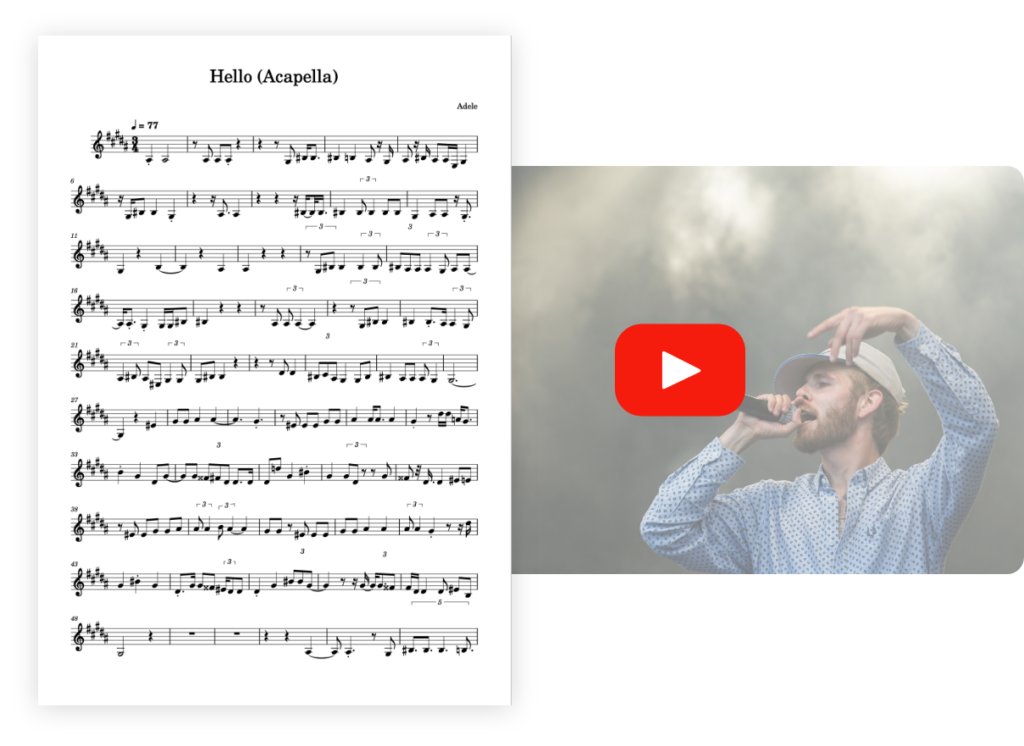
Ideal for: multi-instruments

Transcribe your multi-instrument tracks into sheet music with unrivalled precision.
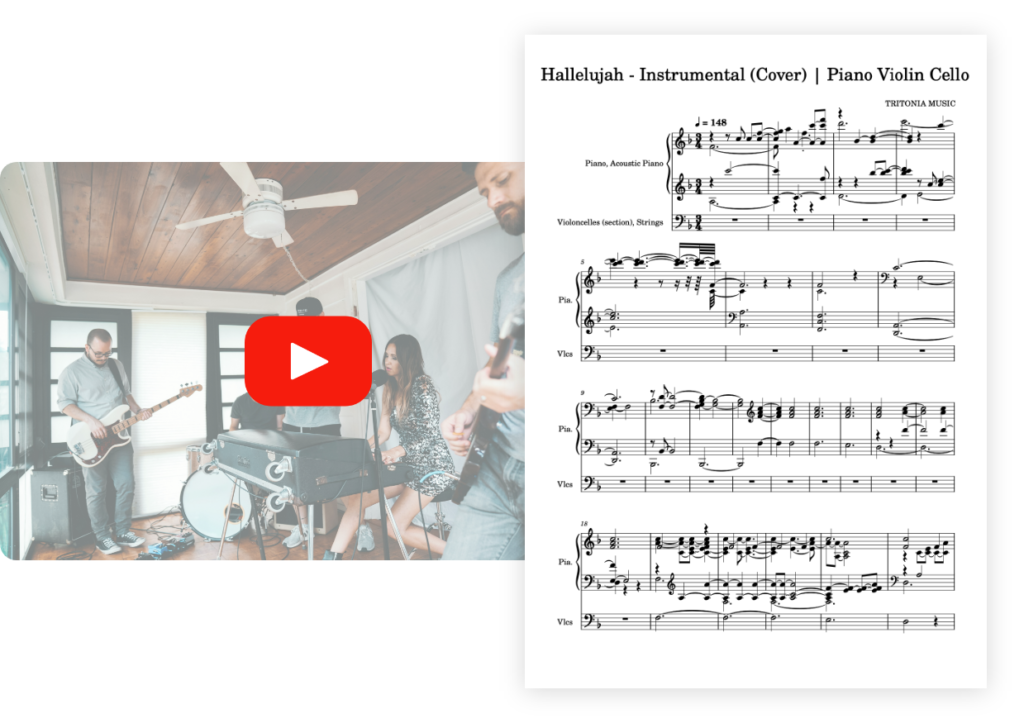
Ideal for: solo drums

Transcribe your drum tracks into sheet music with unrivalled precision.

Ideal for: solo violin

Transcribe your violin pieces into sheet music with unrivalled precision.
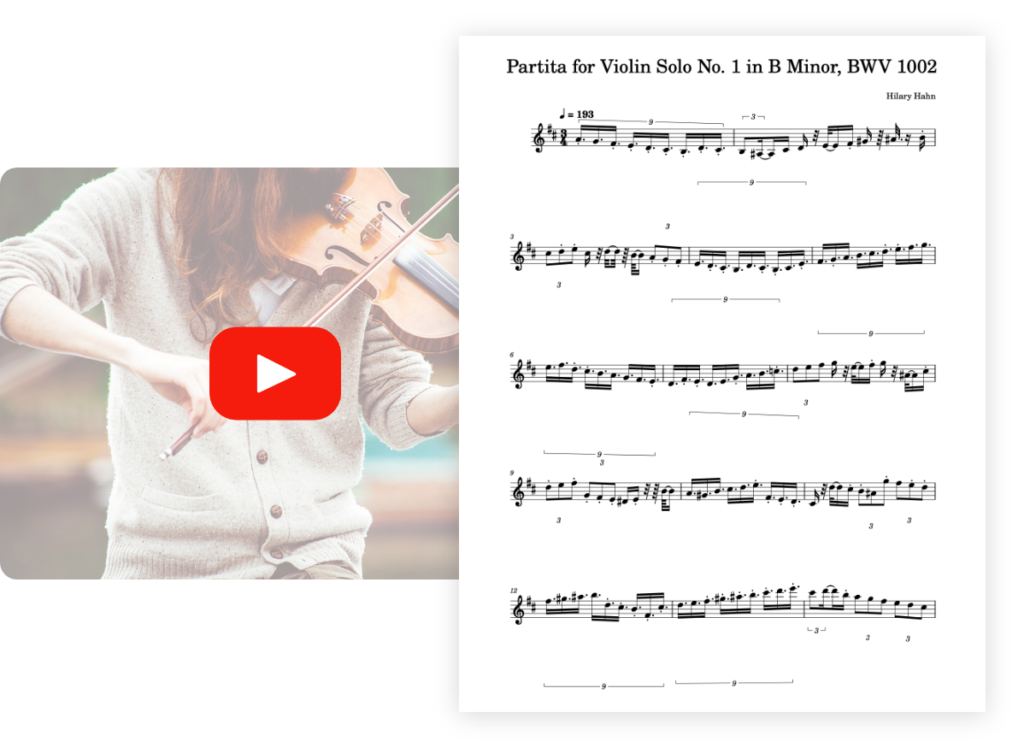
Optimized for: solo saxophone 🎷

Transcribe your saxophone pieces into sheet music with unrivaled precision.

Optimized for : solo flute 🪈

Transcribe your flute pieces into sheet music with unrivaled precision.
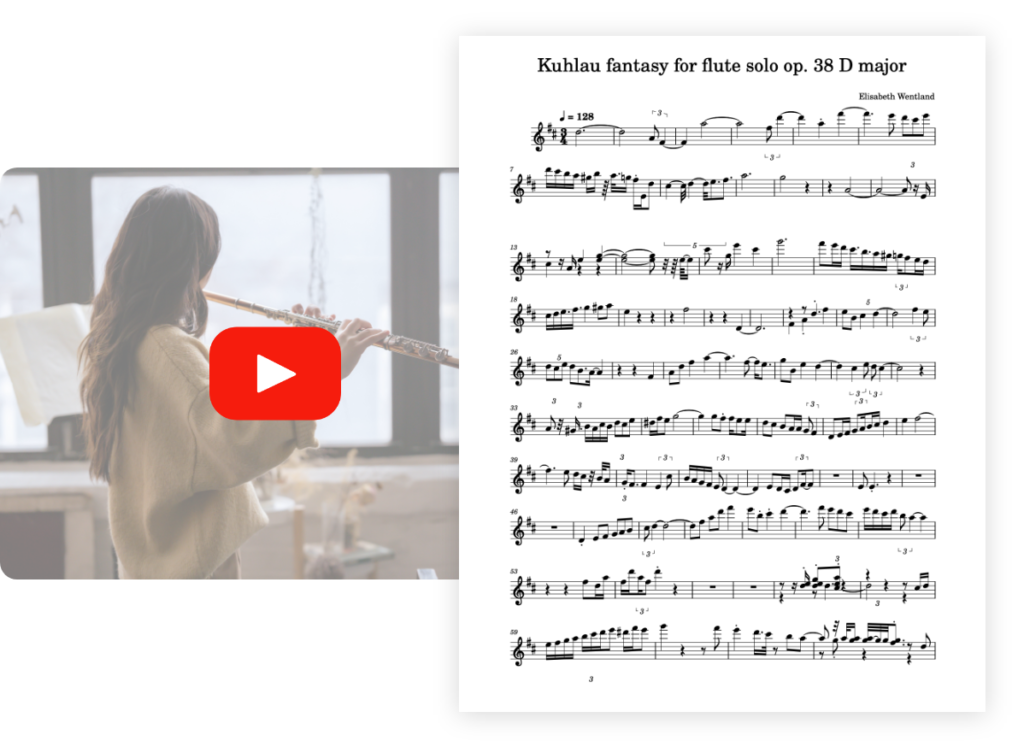
Optimized for : solo bass 🪕

Transcribe your bass pieces into sheet music with unrivaled precision.
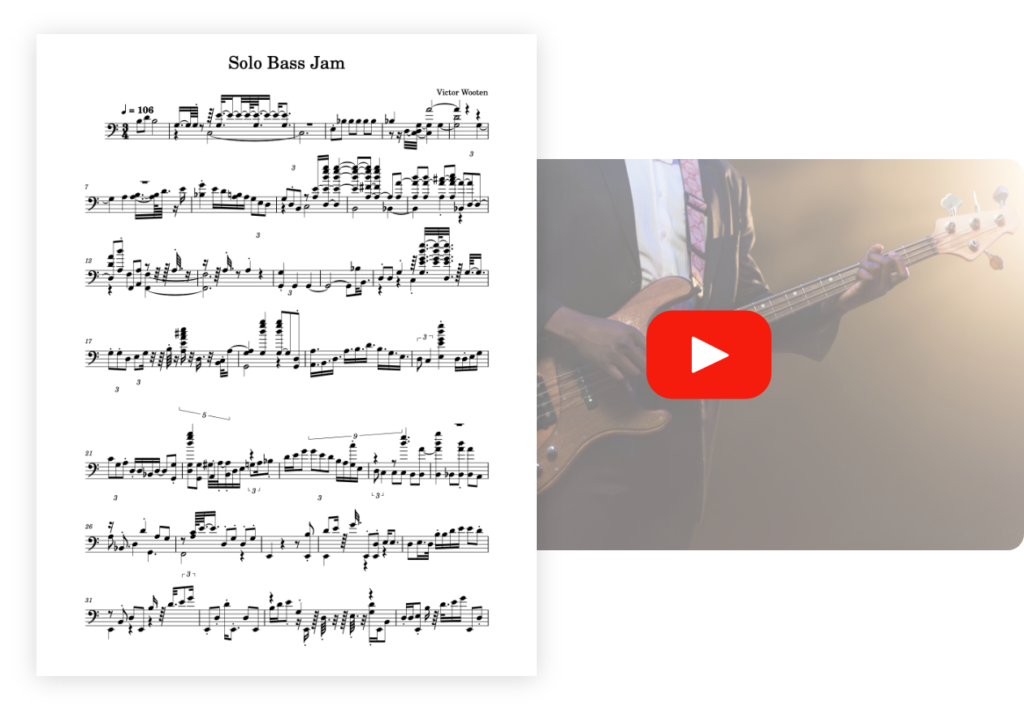
PianoGo lets you learn to play over 3,000 songs easily on the piano.
